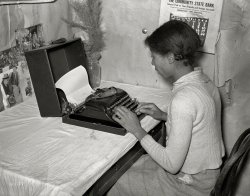
MAY CONTAIN NUTS

Search Shorpy
SHORPY ART

Framed or unframed, desk size to sofa size, printed by us in Arizona and Alabama since 2007. Explore now.
Join and Share
Ad-Free Shorpy
Shorpy is funded by you. Patreon contributors get an ad-free experience.
Learn more.

Recent comments
- Baldwin 62303
- Baldwin VO-1000
- Cold
- No expense spared
- Tough Guys
- Lost in Toyland
- And without gloves
- If I were a blindfolded time traveler
- Smoke Consumer Also Cooks
- Oh that stove!
- Possibly still there?
- What?!?
- $100 Reward
- Freeze Frame
- Texas Flyer wanted
- Just a Year Too Soon
- WWII -- Replacing men with women at the railroad crossing.
- Yes, Icing
- You kids drive me nuts!
- NOT An Easy Job
- I wonder
- Just add window boxes
- Icing Platform?
- Indiana Harbor Belt abides
- Freezing haze
- Corrections (for those who care)
- C&NW at Nelson
- Fallen Flags
- A dangerous job made worse
- Water Stop
Member Photos
The Shorpy
Print Emporium
Print Emporium
Search Shorpy
Search results -- 30 results per page
- Mendon L.D.S. Church: 1940
- ... Church at Mendon, Cache County, Utah." Acetate negative by Russell Lee for the Farm Security Administration. View full size.
Brickolage ... Posted by Dave - 11/19/2020 - 10:04am -
![Mendon L.D.S. Church: 1940 August 1940. "Congregation leaving the Latter Days Saints Church at Mendon, Cache County, Utah." Acetate negative by Russell Lee for the Farm Security Administration. View full size.
Brickolage (part 2)Love the two-tone brickwork. So simple yet so effective.
Sunday BestIt is clear in this Rockwellian scene that the flat-capped boy at the foot of the steps is reconnoitering as to which of those unsuspecting girls will be the one down whose back he will deposit the frog in his pocket.
Sunshine on their shouldersI almost want to squint looking at the image. Sunny day!
Two thingsThing One: The spectacularly symmetrical (and extremely satisfying) composition of this photo is miraculous. The matchless Mr. Lee must have had his tripod set up and everything copacetic before the folks began piling out from services, to get it so perfect. I wonder if he wished he could have gone inside and leveled all of the window shades? I think not. The half-open door with the blackness beyond gives a momentarily unsettling frisson. Even so the picture calms the mind, which, if a photo does not excite the heart, should be the result of gazing at it. The restrained animation of the people adds the metaphor of unpredictability against the backdrop of the subliminally eternal.
Thing Two: The parked perambulator is very Rosemary's Baby. Why something that is not at all anachronistic should seem so creepy is interesting. A bonus for Mr. Lee, after the fact. Bravo. Having lived nearly twenty years after the release of the film, I wonder if he realized it later. At that time it would not have seemed remarkable, but in terms of post-war cinematic iconography, the buggy is a real spanner in the works.
Another one bites the dustSadly, the building lasted just 50 years. I just don't get why nice little historic buildings like this are considered disposable. I'd like to think that the preservation movement of the last couple of decades might have worked to save it from the wrecking ball.
http://www.mendonutah.net/history/buildings/1914_church.htm
Rosemary's BabyGreat comment by JennyPennifer. This is what makes reading the comments as good as looking at the pictures. As for the baby carriage, it made me think immediately of the stairway shootout scene from The Untouchables (1987).
[A scene that was lifted from Eisenstein's "Potemkin." - Dave]
That baby carriage ...I suppose Rosemary's Baby might come to mind. But in 1940, especially next to those steps, it might recall the great Russian film Battleship Potemkin, with the famous sequence of a baby carriage painfully making its way down the steps in Odessa.
Or it might make you wonder if someone has abandoned a foundling there during the service, knowing some saintly soul would adopt it.
In any case, a brilliantly attractive picture there in the Utah sun.
(The Gallery, Kids, Russell Lee)](https://www.shorpy.com/files/images/SHORPY-8b25985a.thumbnail.jpg)
- Minor Surgery: 1939
- ... of glass out of boy's foot." Medium format negative by Russell Lee. View full size.
Foot injuries It's a wonder back in the ... Posted by Dave - 05/04/2018 - 5:29pm -
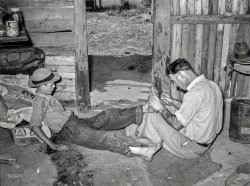
- County Castle: 1940
- ... -- Placer County Courthouse." Medium format negative by Russell Lee for the Farm Security Administration. View full size.
+70 Below ... Posted by Dave - 05/20/2019 - 11:07am -
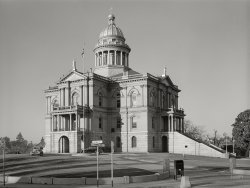
- Cat Patrol: 1940
- ... farmer. Santa Clara, Utah." Medium format negative by Russell Lee for the Farm Security Administration. View full size.
Tale of Two ... Posted by Dave - 04/02/2019 - 1:25pm -
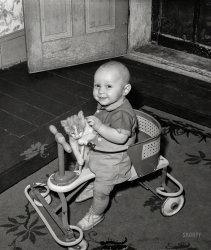
- Rio Grande: 1940
- ... yards. Durango, Colorado." Medium format negative by Russell Lee for the Farm Security Administration. View full size.
The ... was scrapped the next year.
(The Gallery, Railroads, Russell Lee) ... Posted by Dave - 09/05/2018 - 3:03pm -
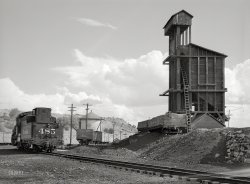
- Dust in the Wind: 1937
- ... near Williston, North Dakota." Medium format negative by Russell Lee for the Farm Security Administration. View full size.
(The Gallery, ... Posted by Dave - 08/17/2013 - 7:36pm -
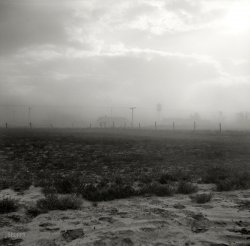
- My Little Piggy: 1941
- ... so he can learn how to feed his pig properly." Photo by Russell Lee, Farm Security Administration. View full size.
Our Gang comedy in ... Posted by Dave - 10/18/2018 - 11:53am -
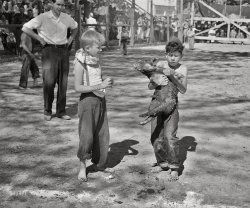
- Tuf Nut: 1940
- ... is lifted from the lucky contestant's overalls. Photo by Russell Lee for the Farm Security Administration. View full size.
Tuf Nut ... Posted by Dave - 07/17/2018 - 2:20pm -
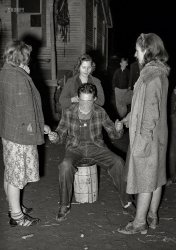
- Whirlpool: 1939
- ... even have a "simmer" setting. 35mm nitrate negative by Russell Lee, Farm Security Administration. View full size.
Maybe the Maytag ... Posted by Dave - 06/25/2012 - 12:16pm -
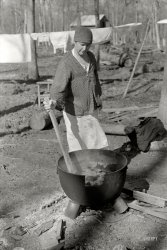
- E Pluribus Unum: 1941
- ... of allegiance over the radio." Medium format negative by Russell Lee for the Farm Security Administration. View full size.
Smoking ... Posted by Dave - 11/01/2018 - 2:39pm -
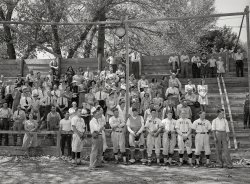
- Texas Turkeys: 1939
- ... house in Brownwood, Texas." Medium format negative by Russell Lee for the Farm Security Administration. View full size.
Just ... Posted by Dave - 06/18/2018 - 8:45pm -
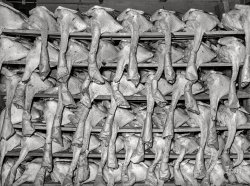
- Thirst Trap: 1940
- ... bar in Mogollon, New Mexico." Medium format negative by Russell Lee for the Farm Security Administration. View full size.
Square ... Posted by Dave - 07/30/2018 - 8:18pm -
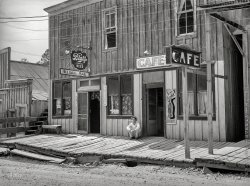
- Progressive Farmer: 1939
- ... porch seen in the previous post. 35mm nitrate negative by Russell Lee for the Farm Security Administration. View full size.
Conservation ... Posted by Dave - 06/24/2012 - 9:50pm -
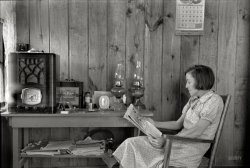
- We Ate the Chickens: 1939
- ... eat my chickens. I get worse off every year'." Photo by Russell Lee. View full size.
Where are they now? I wish there was a way to ... Posted by Dave - 03/27/2018 - 12:13am -
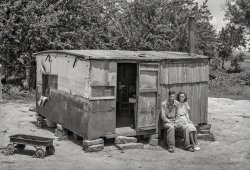
- House & Garden: 1939
- ... Near Santa Maria, Texas." Medium format negative by Russell Lee for the Farm Security Administration. View full size.
"I smell ... Posted by Dave - 04/16/2018 - 8:52am -
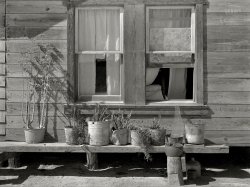
- No Picnic: 1940
- ... miles from San Diego." Medium format acetate negative by Russell Lee documenting life in Southern California during the "Blitz Boom" of ... Posted by Dave - 08/28/2018 - 6:34pm -
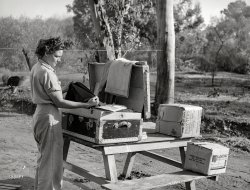
- The Busy Kitchen: 1941
- ... Malheur County, Oregon." Medium format negative by Russell Lee for the Farm Security Administration. View full size.
Wringer ... Posted by Dave - 02/16/2019 - 1:34pm -
![The Busy Kitchen: 1941 May 1941. "Mrs. E.E. Botner, wife of FSA rehabilitation borrower, wringing laundry in electric wringer. This family has been on the project for about five years. Vale-Owyhee irrigation project, Malheur County, Oregon." Medium format negative by Russell Lee for the Farm Security Administration. View full size.
Wringer Washer PrimerSeveral years ago a friend of mine in Vancouver, B.C., bought a Maytag wringer washer that had never been used in forty years since it was new. We fired it up, and I made a YouTube video of its first operation. For those unfamiliar with wringer washers, this should help out. I used machines like this decades ago. In Canada, wringer machines outsold automatics until 1968. In the U.S.A. this point was reached in 1951. One reason for this was that an automatic in Canada cost triple the price of a wringer washer. I have a 1944 Beatty wringer washer I still use from time to time.
Dangerous wringersBack in the '50s my cousin got caught in one of those wringers. It chewed most of the skin off the bottom of his arm before my aunt could get it turned off. He had to wear a brace for several months to hold his arm out so the skin would heal properly. They were afraid his arm would be stuck to his side if they hadn't.
Kid memoryRGraham's photo brought back a long lost memory that made me smile. My mom had a mangle and I loved lying on the floor under it in the kitchen as the warm ironed sheets came off the roller on me as we listened to radio programs like "Life With Luigi" or Henry Aldrich.
What's not to loveElectric stove and washing machine, running water -- all the modern conveniences in 1941. Reminds me of the Uriah Heep tune EZ Livin'.
The rest of the story ...Out of curiosity, I looked up Census Bureau records based on her husband's name, and it is likely Mrs. E.E. (Lula) Botner was about 45 when this photo was taken. It appears she died in 1970 in Idaho. I expect she was probably plumb worn-out!
Life was tough for us ladies back then.
Thet weren't called mangles for nothingLotta fingers (and occasionally other parts of the human anatomy) accidentally passed between those rollers.
Watch that hair!As Ozinor noted, a lot of accidents with those wringers. I can recall hearing stories of women who lost part of their scalps when their long hair got caught in the wringer.
Wringers vs ManglesThe device on the washing machine for squeezing water out of wet laundry is a wringer. A "mangle" was a more common (and descriptive) name for an ironing machine that had two long heated rollers used for ironing flat items. Not many of these were sold because they took up a lot of space, were pricey, and--yes--because they easily mangled the hands of unwary users.
ManglerAlthough I'm sure the wringer was more than capable of sucking in some body parts, the image below is what most people called a "mangler". It was a machine that ironed clothes and most any other items needing ironing. It took some practice to do it correctly.
[That's a mangle, not a "mangler." - Dave]
I guess they are both "mangles". https://en.wikipedia.org/wiki/Mangle_(machine) We still called it the mangler.
Here's a youtube instructional video if you're so inclined to try one out. https://www.youtube.com/watch?v=WkgN2YpeKu0
Power cordI suppose that the electrical cord running straight up near her head is connected to the light socket, and powers the machine. They didn't have convenience outlets back then, in the older houses.
(The Gallery, Kitchens etc., Rural America, Russell Lee)](https://www.shorpy.com/files/images/SHORPY-8c01154a.thumbnail.jpg)
- Shantytown Baby: 1936
- ... Spencer, Iowa." View full size. 35mm negative by Russell Lee.
Poor in Iowa It is hard for me to think of Iowa and poor people. In ... Posted by Dave - 09/09/2011 - 6:52pm -
![Shantytown Baby: 1936 December 1936. "Mrs. Charles Benning and baby in their shack home at Shantytown. Spencer, Iowa." View full size. 35mm negative by Russell Lee.
Poor in IowaIt is hard for me to think of Iowa and poor people. In talking to those that lived through the 1930s, as I did, the people who lived on farms would say how poor they were then add but we had food to eat.
Famine in USA, 7 million died?Dear fellow Americans,
One political party in Ukraine, strictly pro-Russian and anti-NATO and anti-American, is trying to prove that in the USA it had been terrible famine in 1932-33. They base their opinion on some non-correspondences in the statistics, and they calculated that by 1940 the country lost more than 7 million people. But, as thay say, this is strictly hidden by US Govt.
Sorry, this article is in Russian, but link is:
http://vitrenko.at.ua/load/8-1-0-294/
I came to this web-site by their link - they are trying to prove their opinion by photos from this site.
My personal opinion - this version is absolutely bullshit, I can not believe it. Other Ukrainians just laugh upon it and don;'t believe too.
What do you think about this?
[The Great Depression and the Dust Bowl are no secret. But there was no mass starvation with millions dead. To think that such a calamity could be "strictly hidden" in a democracy with a free press is nonsense.
What was "hidden" were the 20 million who died during Stalin's forced collectivization of Soviet agriculture in the 1930s. I suppose there are people in Ukraine who might think the same thing could have happened in America.
Of course it upsets me that anyone would use the photos on this Web site as fodder for Big Lie propaganda.
How do you say "The Progressive Socialist Party of Ukraine is full of crap" in Russian? (Or, more seriously, that such claims are untrue.) If I can figure out how to do the Cyrillic alphabet I'll put it on the page they're linking to.
Thanks very much for writing. - Dave]
Famine in Ukraine 1932-33, Great Depression in the USADear Dave,
Thank you very much for your response!
I absolutely agree with you.
>How do you say "The Progressive Socialist Party of >Ukraine is full of crap" in Russian?
If to use Latin letters and Russian language, we can say "Progressivno-socialisticheskaya partiya Ukrainy- polnaya der'ma".
Their leader, Natalya Vitrenko is commonly considered in Ukraine as the Witch of Konotop town, crazy ugly old wife and Kremlin-paid clown.
My grandparents remember terrible 1930s, famine and collectivization and they survived only by miracle - all of them had been students in cities who received some little food and money.
They told me much about the villages, circled with Red Army and OGPU forces, about all kinds of food taken off by commi-activists, about cannibalism among the people who got mad from hunger, at last.
It's terrible, and for first time I heard about these things in 1988, when first publications got thorough communists propaganda cover.
I just wonder that big depression looks very much like it was here in the USSR, but I don't thing some people ate another humans in USA, because government didn't take all food from people to punish them.
Also I think that it is absolutely impossible to hide such things, as an example one can mention Monica-Clinton scandal.
Dave, if I can help you with translation of some inscriptions into/from Russian-Ukrainian languages, feel free to write me at:
[.....@...]
I understand that my English is not very good and sometimes funny, but I can express my opinions and understand the others.
Thanks again!
Andriy
[Well darn, I see that our website does not let people use Cyrillic characters. (Although one Cyrillic character, this Natalya person, is certainly using us.) Thanks again for writing. Your English is much better than my Ukrainian. Maybe my neighbor Ilya can help. I really was hoping to get involved in a good old-fashioned Cold War dustup this week. - Dave]
The DepressionI think it is important to follow up Dave’s succinct riposte and answer Ukrainian from Odessa’s assertion with some demonstrable facts. There, indeed, were crop failures and economic devastation in 1933-1934, but let’s examine the depth and breadth of the damage along with the response by the United States government:
In the mid-1930’s the US national median income was $1,500. Only 16% of farm families earned that much or more. More than half of all US farm families had annual incomes of less than $1,000. In 1934, per capita income of farm households was just $167. Only 10% had indoor toilets, 20% had electricity. More than 1,300 rural counties in the US had no general hospital and most lacked even a public health nurse. Illiteracy was twice as common in rural districts as in cities. Nearly 1 million rural children did not attend school at all. 1
Dismal picture, yes – but what was done about it? The federal government, led by Franklin Roosevelt and a progressive Congress, instituted a series of emergency measures and agencies – popularly known as the “New Deal”. These government responses included the Civil Works Administration and the Farm Security Administration, under whose auspices many of the photos here on Shorpy were made and cataloged. Without citing loads of economic data, suffice it to say that by 1938 enough progress had been made that most of the “alphabet soup” federal agencies had been de-funded and the economy had rebounded with help from sharply increased munitions production. 2
The message for our Ukrainian friend is that while there were many political and economic factors that could have led to U.S. famine and starvation in the 1930’s, they were largely avoided as the result of (sometimes painful) government actions. Nobody starved. Nobody allowed anyone to starve – much less engineered it. You can check this out yourself – all of our records are open free. Come have a look.
1 Ann Rochester, Why Farmers Are Poor, (NY: INternational Publishers, 1940)
2 David M. Kennedy, Freedom From Fear - The American People in Depression and War, 1929-1945, (NY: Oxford University Press, 2005)
"I must put a goat on."
Winston Churchill (possibly misheard)
Goober Pea
Natalya and VladAlrighty. I've posted this at the top of the page that Natalya's website is linking to. Can anyone translate the comments on that webpage?
This Great Depression will
["Realties" -- isn't that what got us into this mess in the first place? We'll be right back with Part 2 of this windy diatribe after a brief intermission. - Dave]
(The Gallery, Great Depression, Kids, Russell Lee)](https://www.shorpy.com/files/images/8a21398u1.thumbnail.jpg)
- Williams County IV: 1937
- ... Williams County, North Dakota. 35mm nitrate negative by Russell Lee, Farm Security Administration. View full size.
(The Gallery, ... Posted by Dave - 09/08/2011 - 9:36pm -
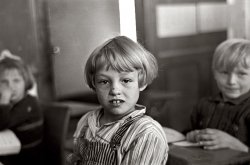
- A Busier Bisbee: 1940
- ... Arizona. Copper mining center." Medium format negative by Russell Lee for the Farm Security Administration. View full size.
Walgreen ... Posted by Dave - 10/23/2018 - 7:06pm -
![A Busier Bisbee: 1940 May 1940. "Main street of Bisbee, Arizona. Copper mining center." Medium format negative by Russell Lee for the Farm Security Administration. View full size.
Walgreen AgencyNote the Walgreen Agency drugstore.
"One of the most significant expansions during the 1930s was the establishment of an agency cooperative purchasing system, whereby Walgreen's products became available in a number of independent pharmacies. By 1934, there were 600 agencies in 33 US states, stocking over 1,000 Walgreen's products. At its peak the Walgreen's Agency system had more than 2,000 participants within the network. The system continued until 1980, when the administration of the cooperative purchasing program was discontinued."
On another note, Walgreen's invented the Malted Milkshake. I did not know that.
Copper Mining EconomicsIn the 1970's, I lived a few months in Ajo, Arizona. Phelps Dodge operated an open pit copper mine and smelter there. It was a company town. The price of copper spiked while I was there, and the workers were put on a 12 hour workday, seven days a week for four weeks, and then took a weekend off. On Monday, they started a new cycle of 12 on and 12 off. Most of the modest housing was built by Phelps Dodge and rented to the workers. After working for Phelps Dodge for five years, the workers could buy their house for $1.
National brands squeezing out the local guysThis is 1940 and I see Walgreen's, JC Penney, Woolworth's, Coca-Cola, Florsheim, Rexall, and maybe Blue Ribbon.
I hear so much about Chain Stores and national brands squeezing local stores as some modern problem, and here we are in the photograph. All we need is for that business at the end of the street to be a Sears. Many years ago Sears was accused of shutting down Main Street as Wal-Mart is today.
[That's the company store at the end of the street -- Phelps-Dodge Mercantile. - Dave]
Neon Signage lit up at nightI imagine it sure would've looked pretty. And attention grabbing.
The Review lives on. Looking from the other end of the street. More of the Bisbee Daily Review.
(The Gallery, Cars, Trucks, Buses, Russell Lee, Small Towns)](https://www.shorpy.com/files/images/SHORPY-8b24959a.thumbnail.jpg)
- The Fat Stock Show: 1940
- ... Stock Show. San Angelo, Texas." Medium format negative by Russell Lee for the Farm Security Administration. View full size.
Still going - ... Posted by Dave - 06/27/2018 - 8:55am -
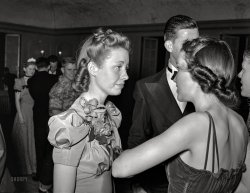
- Self-Propelled: 1940
- ... workmen with handcar. Oklahoma City, Oklahoma." Photo by Russell Lee for the Farm Security Administration. View full size.
Hard work all ... Posted by Dave - 07/20/2018 - 11:43am -
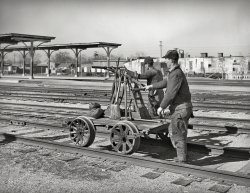
- Denizens of Gonzales: 1939
- ... in Gonzales, Texas." Medium format acetate negative by Russell Lee for the Farm Security Administration. View full size.
Come and Take ... Posted by Dave - 09/20/2018 - 10:22pm -
![Denizens of Gonzales: 1939 November 1939. "Street corner in Gonzales, Texas." Medium format acetate negative by Russell Lee for the Farm Security Administration. View full size.
Come and Take It Freddy223's Google picture is from 2011 and the Guadalajara is now history. The 2016 picture shows unfortunate alterations that will soon become outdoor seating for the Come and Take It Bar and Grill which, to date, seems to be surviving.
["Unfortunate"? Looks nice to me. - Dave]
Still There
GUADALUPE SANITARIUMI noticed the sign at the very top of the building.
Open For Business1915 - On February 5, the Guadalupe Sanitarium is now open and has two patients.
http://www.gonzalesinquirer.com/stories/gonzales-county-chronological-hi...
Start 'em youngFuture shopper checking out the shirt display.
St. George at St. JosephStorefronts are changed but this is the same building. Even the telephone pole and fire hydrant are in the same place.
In 80 years... nothing has changed in the way shirts are wrapped. It takes 10 minutes to get all the pins out!
Great typesI mean no disrespect to the men in this photograph, but each could easily be a caricature (from left): the plywood cowboy silhouette cutout with bent knee; the friendly Latino sidekick; the slack-jawed yokel using every ounce of his concentration to roll a cigarette; the toothless old git; and the black dude with the great shoes and hat at an extreme angle, striking a crazy pose.
Sheath DressingThe two phone cables visible here appear to have a lead sheath. This was pretty standard until sometime after WWII, when various kinds of plastic sheath came into use.
I have a Bell System manual from 1983 that still has a procedure (from 1969) for installing lead splice cases on lead-sheath cable. The case started out as a tube, and if it was pretty close to the diameter of the cable, you were supposed to just beat the ends down to the cable sheath and solder. The splice just to the right of the pole, for the small cable down to the box on the pole, looks to have been done this way.
If the splice case was much larger than the cable, you were expected to cast (!) end plates for the case to match the cable, using a set of molds and a pot of molten lead (!!). You then soldered the end plates to the case, and to the cable.
A little later on, Ma Bell figured out that lead might not exactly be good for you. There are some additional procedures (from 1979) about using some goop on the lead before you used a wire brush on it (to contain the dust), that it was important to pull lead cable out of a manhole without scraping it on the edge of the hole (to avoid dust), and that employees were only allowed to work half a day handling lead cable.
(The Gallery, Russell Lee, Stores & Markets)](https://www.shorpy.com/files/images/SHORPY-8b23265a.thumbnail.jpg)
- In the Cards: 1938
- ... Louisiana." View full size. 35mm nitrate negative by Russell Lee for the FSA.
(The Gallery, Russell Lee, Stores & Markets) ... Posted by Dave - 12/10/2007 - 1:50pm -
![In the Cards: 1938 September 1938. "Game of cooncan [conquian] in store near Reserve, Louisiana." View full size. 35mm nitrate negative by Russell Lee for the FSA.
(The Gallery, Russell Lee, Stores & Markets)](https://www.shorpy.com/files/images/8a23536u.thumbnail.jpg)
- Take Five: 1940
- ... resting between periods. Eufaula, Oklahoma." Photo by Russell Lee for the Farm Security Administration. View full size.
The song ... Posted by Dave - 07/19/2018 - 11:14am -
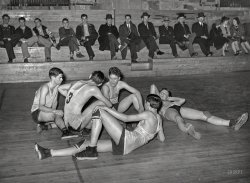
- Lois at the Piano: 1936
- ... View full size. Medium format nitrate negative by Russell Lee.
(The Gallery, Music, Russell Lee) ... Posted by Dave - 09/09/2011 - 2:39pm -
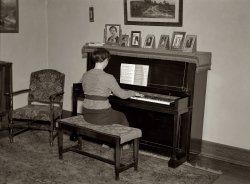
- Williams County I: 1937
- ... Williams County, North Dakota. 35mm nitrate negative by Russell Lee, Farm Security Administration. View full size.
(The Gallery, ... Posted by Dave - 09/08/2011 - 9:40pm -

- Tiny Courthouse: 1937
- ... County, Montana." Medium format acetate negative by Russell Lee for the Farm Security Administration. View full size.
Evidently, ... go for small claims.
(The Gallery, Frontier Life, Russell Lee) ... Posted by Dave - 03/05/2018 - 9:26am -
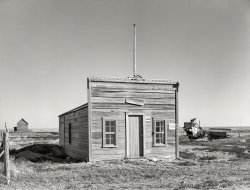
- Back at Work: 1938
- ... Lasses White traveling show. Sikeston, Missouri." Photo by Russell Lee. View full size.
Dream job A roustabout! One of my dream jobs. ... Posted by Dave - 12/14/2018 - 4:09pm -
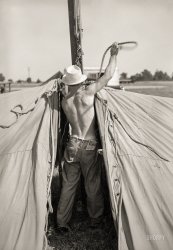
- Dear Sis: 1940
- ... most prized family possession." Medium format negative by Russell Lee for the Farm Security Administration. View full size.
1940 Macbook ... Posted by Dave - 07/20/2018 - 7:15pm -
